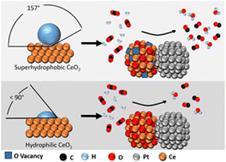
RSC Applied Interfaces has published its first articles which can be read for free here. To celebrate publishing our first articles, we asked some of our authors to discuss their work in more detail.
In this post, we hear from Kauê Santos and Fabiano Bernardi from Universidade Federal do Rio Grande do Sul, Brazil, as they discuss their recently published article entitled ‘Engineering Pt–CeO2 interfaces for reverse water-gas shift (RWGS) reaction’.
Discover the full article here
 Engineering Pt–CeO2 interfaces for reverse water-gas shift (RWGS) reaction
Engineering Pt–CeO2 interfaces for reverse water-gas shift (RWGS) reaction
Kauê G. G. dos Santos, Alisson S. Thill, Livia P. Matte, Gustavo Z. Girotto, Mateus V. Costa, Denise R. Bohn, Fernanda Poletto and Fabiano Bernardi
RSC Appl. Interfaces, 2024, 1, 992-1000. DOI: 10.1039/D4LF00064A
Meet the authors

Bernardi group

Kauê Santos
Kauê Santos completed his undergraduate Bachelor’s in Physics and his Master’s degree in Physics at the Federal University of Rio Grande do Sul (UFRGS) in 2020 and 2023, respectively. During this period, he investigated the dissociation of CO2 molecules through the RWGS reaction. He is currently pursuing his PhD in Physics, also at UFRGS. Now, his focus remains on environmental issues, but this time dedicated to hydrogen storage in solid materials.

Fabiano Bernardi
Fabiano Bernardi is Associate Professor and Head of the Physics of Nanostructures Lab at Universidade Federal do Rio Grande do Sul (UFRGS). He was Director of the Centro de Nanociência e Nanotecnologia (CNANO), and is currently Deputy Director of the CNANO and Centro de Microscopia e Microanálise (CMM) at UFRGS. He earned his PhD in Physics at UFRGS. The main research line is Surface and Interface Physics and it is devoted to study metal/metal oxide nanoparticles used in the hydrogen storage, heterogeneous catalysis (mainly but not restricted to CO2 dissociation), photocatalytic hydrogen production, artificial photosynthesis, and photodegradation of dyes.

